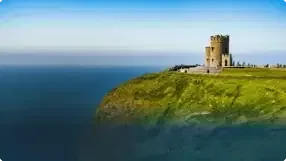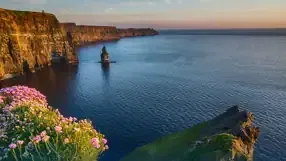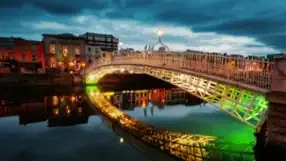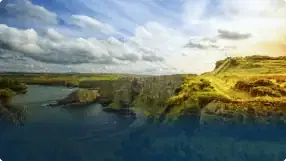Visiting Cork
Thinking of visiting Cork? Visit quaint towns and villages, take in breathtaking landscapes, and indulge in the best cuisine around.

Visiting Cork Public Museum
Cork’s main museum is located in Fitzgerald Park and offers a comprehensive view into local history and culture. It’s located next to the University College Cork and can easily be visited in the same outing with UCC. This is arguably Cork’s most important attraction, and visitors are welcomed free of charge.
The Georgian building that houses Cork Public Museum was constructed by the Beamish family in 1845. It has served as a museum in one form or another for many years. In the early 1900s, it housed the Cork International Exhibition for a year. After that, the area was named a public park.
The unequivocal highlight of the museum is its archaeological collections. These have been unearthed and excavated in the region, and they shed light on the lives and times of the prehistoric civilisations that once prospered here.
There is also an emphasis on the trades and crafts of cork, particularly as it pertains to Cork silver. Some of the silver on displays dates to the 1700s. There are also exhibits devoted to the Irish struggle for independence, with special focus given to Tomas MacCurtain and Terence MacSwiney, who were the first and second Republican Lord Mayors of Cork. Historical documents and photographs round out these exhibits.
An extension to the museum was unveiled in 2005. In the same year, Cork was named a European Capital of Culture, a title worthy of state-of-the-art upgrades for the museum. The extension left the museum with substantially more display space, allowing curators to bring volumes of artefacts out of storage and into the public eye.
After visiting the museum, spend some exploring Fitzgerald Park. Grab a bite to eat at Riverview Café or sit on the edge of the pond and admire the swans. The river Lee also passes through the park, and Daly’s Bridge (a pedestrian bridge) crosses to Sundays Well Road.
Book your Cork Car Hire today

Cork Vision Centre
The Cork Vision Centre is a unique exhibition space that’s worth visiting just for a chance to appreciate the venue, alone. It hosts a regular line-up of events throughout the year, and availability depends a great deal on when you visit. Pricing for individual exhibitions and events vary, but the centre itself is free to explore from 10:00 am to 5:00 pm from Tuesday to Saturday.
The Vision Centre is located within St Peter’s Church on Main Street. The church was decommissioned, and it now serves as gallery and exhibition space for the city of Cork. With this in mind, it is situated at the heart of historic Cork City, within walking distance of many key attractions, art galleries and historic sites.
The Vision Centre is also working to restore St Peter’s. The building dates back to the 13th century, when King Henry III conveyed patronage of the church to the Bishop of Cork. The church went out of use in 1949 and remained in a state of disrepair until 1988, when the City Council launched a restoration project and opened reopened the church as a cultural facility. In the decades since, the centre has won several awards – both nationally and abroad. Downloadable guided tours (audio and text) of St Peter’s architecture are available.
One unexpected highlight of the exhibition space is a large model of Cork city. This model helps put the river Lee in its proper context, so that you can see how it frames the downtown district.
Walking Tours in Cork
Cork may be Ireland’s second-largest city, but it’s still small enough to cross on foot. That makes time spent here that much more rewarding. With that in mind, the Cork City Council has put together a series of free, self-guided walking tours of the city. Each offers its own unique perspective on the city. The following three self-guided tours have been organised by the City Council:
The City Centre Island Walk
This walk focuses on Cork’s city centre, following several river channels that once divided a series of islands. Today, many of these former channels are now prominent streets – including St Patrick’s Street, the Grand Parade and the South Mall. The tour goes on to explore the bridges spanning the river Lee, each of which has its own story to tell. All of this connects back to the important role that trade played in the development of Cork and its culture.
The Shandon Walk
This walk covers much of the most important historic ground in Cork. It revolves around the Butter Exchange complex, which was one of the most important economic strongholds of old Cork. It goes on to explore the city’s architecture as well as the socio-political shifts that fuelled the shift from Catholicism to Anglican and back to Catholicism. Many of the historic thoroughfares of trade featured on this walk are still important strands of commerce to this very day.
The South Parish Walk
This particular walk takes a deeper look at Cork’s development from marshy river land to Ireland’s second city. It takes in churches, mills, breweries and historic houses in the city. Many of the place names along this route connect back to prominent families that played integral roles in Cork’s development.

Visiting St Anne's Church, Cork
The Church of Saint Anne stands in the Shandon district and overlooks Cork city. It’s a postcard-worthy icon of Ireland’s second city and is featured in the famous song, The Bells of Shandon, by Francis Sylvester Mahoney (Father Prout).
The church has a long and involved history. The area in which it is located – Shandon – is an adaptation of the old Irish word for ‘old fort’ (‘sean dun’), and this points to the fact this area has been inhabited in one form or another for ages. The North Cathedral, as it is also known, is situated at the upper end up Shandon Street and dates to the 19th century. However, a medieval church of St Mary also stood on this site. It’s referenced in documents left by Pope Innocent III in the 12th century.
The Siege of Cork in the late 17th century destroyed that cathedral, and a new church of St Mary was built down the road on Mallow Lane. A population boom led to rebuilding a church on the original site, which left us with the foundations of the structure seen today.
Ringing the bells
The famous Bells of Shandon are kept in a 170-foot tower (if the pepper pot adornment at the top is included). The salmon-shaped weather vane on top of the pepper pot represents fishing in the river Lee.
Bear in mind that admission to the Church of St Anne is free, as this remains an active place of worship. However, getting a close-up view of the bells requires paying a few Euro per head. Visitors can ring the bells at the bottom of the tower and then proceed up the stairs for impressive panoramic views of Cork city.
Connect with St Anne’s Church on Facebook.
The English Market
The English Market is a longstanding tradition in Cork. It dates to 1610, when King James I issued a royal charter. By most peoples’ reckoning, this is the finest food market in all of Ireland. Best of all, this is an authentic part of the Cork community, which means anyone who pleases can visit at will.
There’s nothing particularly English about the English market, except for the fact that it was built at a time when England maintained a presence in Ireland. Locals took to calling it the ‘English Market’ from the 1800s to distinguish it from St Peter’s Market, which was also in the area. The latter was called the ‘Irish Market’.
The original market was not located on the present location. It moved here in 1788, when the buildings that you see today were built. They were, however, destroyed by a fire in the mid-1800s, and most of the major construction dates to the rebuild that followed.
Visiting the market is all about indulging in the pleasures of daily life. This has, without a doubt, become a tourist attraction. However, it also serves a role in the community. Some of the family businesses that operate here – such as Bresnan’s meat seller – have been on site for several generations.
Cork is regarded the ‘Food Capital of Ireland’, and the English Market is the perfect place to take your own personal tour of what’s available. Dive into local cuisine, including traditional delicacies such as pigs’ feet, tripe and blood sausage – each with their own local names – or stick to the standard cafés and soup bars for a tamer experience.

Visiting Lewis Glucksman Gallery
The University College Cork is an extension of Ireland’s National University system, and it’s located on Western Road in the city centre. It’s a lovely attraction in its own right, with gardens, historical buildings and a few regional claims to fame. The campus is well-shaded, and there is plenty of space for leisurely walks talking in the Gothic Revival architecture.
The highlight of UCC is the Lewis Glucksman Gallery. It’s housed in an arresting structure built of limestone, wood and steel. The gallery displays contemporary art both from Ireland and abroad, and the fact that it is located on a university campus means that it gets plenty of routine visitors throughout the year.
The gallery opened in 2004 and has three storeys’ worth of display area. Upon opening, the building was considered for several architectural awards, including a RIBA Award and the UK Civic Trust Award. Admission to the museum is free, though most visitors make a modest donation – usually something on the order of €5.
The University College Cork collection is comprised of roughly 350 works of art, and these are displayed across campus. The exhibition space in the gallery rotates in and out with temporary displays. Past exhibits have included ‘The Experience of Illness as Art’, ‘Drawing and the Moving Image’ and ‘Globalisation in Contemporary European Video’.
There are several other attractions on the campus that are worth visiting. The Stone Corridor is a collection of stones that have been carved and engraved with the Ogham, a medieval style of Irish writing. Meanwhile, the Crawford Observatory is notable as one of few remaining historical observatories in Ireland (and the only one on a university campus). It was built in 1880, recently underwent an €800,000 restoration project and is now open to the public.

Visiting Bantry House
Bantry House is one of the most popular attractions in Ireland, and it breathes character and drama. Built at the foot of a terraced garden, the Bantry House is beautiful from every angle – whether it be across Bantry Bay, from Whiddy Island or atop the Caha mountains.
The interior of Bantry House is equally striking, filled with elaborate French furniture, works of art and tapestries. The whole place perfectly illustrates the Baroque style. The original house was called Blackrock and was built by Samuel Hutchinson in 1720. The original structure survives at the centre of the present house.
Richard White, a wealthy farmer, bought the house it in 1746. He then proceeded to buy up the lands surrounding Bantry, including large swathes of the Beara Peninsula. His grandson, Richard White, then further expanded the property. A series of new renovations and additions took place in the following years.
In 1820, a two-storey addition was built onto the house. In 1845, a 14-bay block was constructed at the rear of the old house, and it was used to contain the art objects and European furnishing of the viscount at the time. Over the years, despite the series of additions to the house, it has retained its original beauty and friendly atmosphere. Travellers who want to visit Bantry House, or any of the beautiful Irish tourist destinations, can travel by car.
Start your searchRelated Articles

Top 10 family outings in Ireland
If you're organising a family trip to explore Ireland, have a look at the recommendations here before making travel plans.
Learn More
About the Wild Atlantic Way
Discover our top tips for Ireland's 2,500 kilometres of breathtaking coastline with white sands and sparkling waves along the Wild Atlantic Way path.
Learn More
Top 10 things to do in Dublin
Whether you are looking for a day out, or more Dublin tourist information about what should be on your list of things to do, look no further!
Learn More
About car hire excess
Before you hit the road, it's crucial to understand car hire excess and how it works, especially when you're travelling in a foreign country.
Learn More